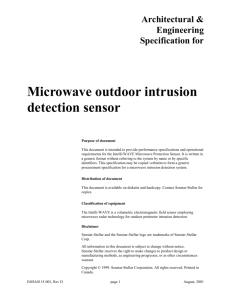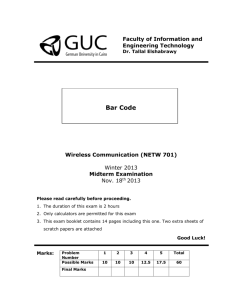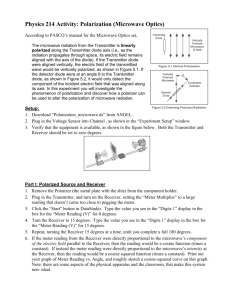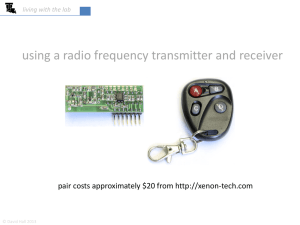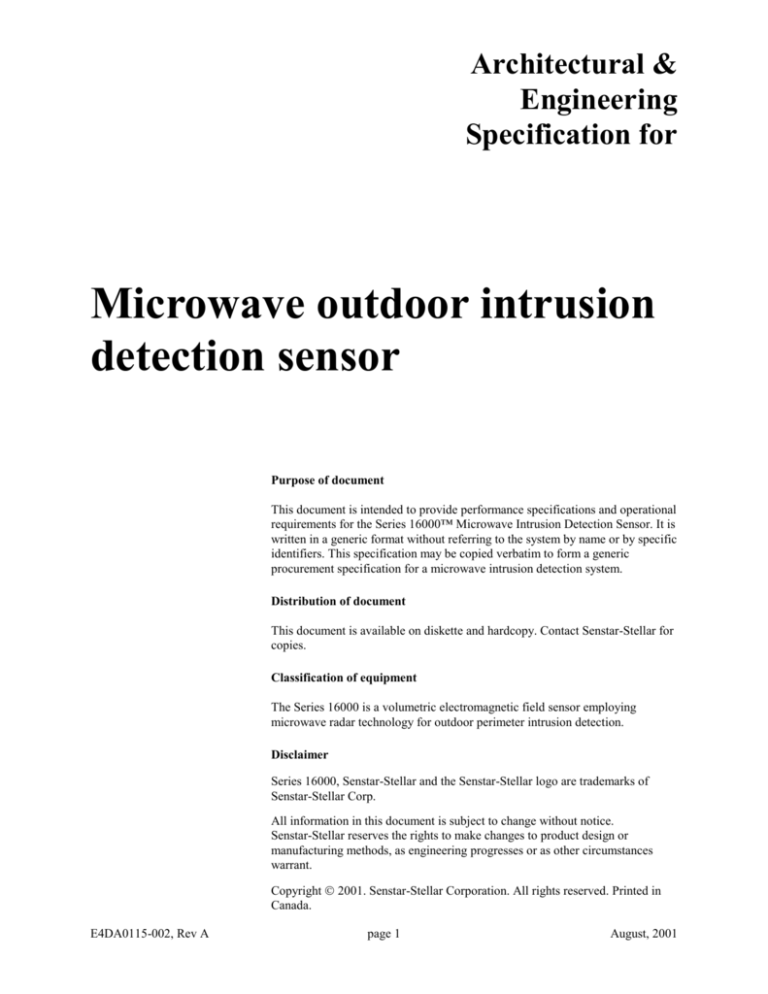
Architectural &
Engineering
Specification for
Microwave outdoor intrusion
detection sensor
Purpose of document
This document is intended to provide performance specifications and operational
requirements for the Series 16000™ Microwave Intrusion Detection Sensor. It is
written in a generic format without referring to the system by name or by specific
identifiers. This specification may be copied verbatim to form a generic
procurement specification for a microwave intrusion detection system.
Distribution of document
This document is available on diskette and hardcopy. Contact Senstar-Stellar for
copies.
Classification of equipment
The Series 16000 is a volumetric electromagnetic field sensor employing
microwave radar technology for outdoor perimeter intrusion detection.
Disclaimer
Series 16000, Senstar-Stellar and the Senstar-Stellar logo are trademarks of
Senstar-Stellar Corp.
All information in this document is subject to change without notice.
Senstar-Stellar reserves the rights to make changes to product design or
manufacturing methods, as engineering progresses or as other circumstances
warrant.
Copyright 2001. Senstar-Stellar Corporation. All rights reserved. Printed in
Canada.
E4DA0115-002, Rev A
page 1
August, 2001
Architectural & Engineering Specification
for Microwave Outdoor Intrusion Detection Sensor
August, 2001
page 2
E4DA0115-002, Rev A
Architectural & Engineering Specification
for Microwave Outdoor Intrusion Detection Sensor
Contents
E4DA0115-002, Rev A
1.0
General performance specifications .......................5
2.0
Sensor processor specifications .............................7
3.0
System installation and commissioning .............. 10
4.0
System maintenance and repair ........................... 11
5.0
Product certifications .......................................... 11
6.0
System availability .............................................. 12
page 3
August, 2001
Architectural & Engineering Specification
for Microwave Outdoor Intrusion Detection Sensor
August, 2001
page 4
E4DA0115-002, Rev A
Architectural & Engineering Specification
for Microwave Outdoor Intrusion Detection Sensor
1.0
General performance specifications
1.1
System description
The system shall be a modular microwave outdoor intrusion detection sensor
based on microwave radar technology. The detection field shall be formed by
radio frequency (RF) signals, in the X-band, carried between a transmitter and a
receiver. The RF signals shall form an invisible electromagnetic detection field
that can detect the presence of an intruder crossing it.
A transmitter shall create the RF signals that form the detection field. A receiver
shall house the necessary electronics to monitor the detection field and to raise
an alarm when an intruder enters the field. The transmitter and receiver shall be
powered individually, as a standalone unit.
1.2
System technology
1.2.1
Microwave
The system shall operate in the X band of the electromagnetic spectrum at a
frequency of 10.525 0.025 GHz, or as approved by local authorities for this
band, with Class A2 modulation at one of six (6) selectable crystal-controlled
frequencies.
1.2.2
Electromagnetic wave
An electromagnetic wave is emitted by the antenna of the transmitter and
received by the antenna of the receiver. The receiver shall detect changes to the
wave that are caused by the presence of an intruder.
1.3
Detection properties
1.3.1
Detection sensitivity
The system shall detect moving intruders having a significant electromagnetic
cross-section (e.g. humans, vehicles, and other large conductive objects) while
rejecting other environmental stimuli.
1.3.2
Detection performance
1.3.2.1 Probability of detection (PD)
The probability of detecting a human intruder weighing more than 34 kg (75 lb.)
walking across the detection zone at random locations shall be 99% with a 95%
confidence factor.
E4DA0115-002, Rev A
page 5
August, 2001
Architectural & Engineering Specification
for Microwave Outdoor Intrusion Detection Sensor
1.3.2.2 Velocity response
The system shall be capable of detecting human intruders moving through the
detection field at speeds ranging from 0.025 m/sec. (1.0 in./sec.) to 8 m/sec (26
ft./sec.), regardless of the direction of motion.
1.3.2.3 Crossing types
The system shall be capable of detecting human intruders who walk, crawl, roll,
jump, or run through the detection field.
1.3.3
False/nuisance alarms
False and nuisance alarms are divided into the two categories listed below.
1.3.3.1 System-generated alarms (false alarms)
Alarms generated by internal electronic processes (cables excluded) shall not
occur at a rate greater than one per zone per month, averaged over the total
number of zones in the system.
1.3.3.2 Environmental alarms (nuisance alarms)
The system shall operate within specifications in typical outdoor environments.
The system must be installed in accordance with the manufacturer's
recommendations in order to maintain the full PD for valid intruders while
minimizing false alarms from the following stimuli:
August, 2001
Vegetation up to 30 cm (1 ft.) high
Rain up to 10 cm/h (4 in./h)
Sunrise/sunset
Wind
Temperature changes
Snow
Hail
Fog
Sandstorms
Motion of nearby objects (vehicles, etc.)
Motion of surface or underground water
Nearby radio-frequency sources
Seismic vibration
Acoustic or magnetic effects
page 6
E4DA0115-002, Rev A
Architectural & Engineering Specification
for Microwave Outdoor Intrusion Detection Sensor
Before installation, the installer shall alert the customer, in writing, as to all sitespecific conditions, which may contribute to an increased nuisance alarm rate.
The customer shall decide whether to remedy the situation or accept the nuisance
alarm sources without any further responsibility on the part of the installer or the
manufacturer.
1.4
Sensor characteristics
1.4.1
Zone length
The system shall be capable of providing detection coverage at distances ranging
between a minimum of 3.0 m (10 ft.) and a maximum of 243 m (800 ft.) per
zone.
1.4.2
Antenna
The transmitting and receiving antennae shall be vertical E-plane polarized. The
antennae shall be field adjustable to three different patterns (11 o, 16 o and 24 o) to
optimize sensitivity to zone length. There shall be a horizontal E-plane antenna
polarization available as an option.
1.5
Performance history
1.5.1
Previous installations
The system shall have been installed in at least ten similar configurations. A list
of these projects shall be available.
1.5.2
Customer references
The vendor shall submit the names and telephone numbers of at least four users
who shall serve as references for the satisfactory performance of the equipment.
These users shall have a minimum performance experience of one year with the
equipment.
2.0
Sensor processor specifications
2.1
Processor description
The receiver shall contain the necessary electronics to perform the signal
processing for the detection zone. The transmitter and receiver shall be operated
as a standalone unit with independent power and data. Both the transmitter and
receiver shall be installed in weatherproof enclosures, when mounted outdoors.
E4DA0115-002, Rev A
page 7
August, 2001
Architectural & Engineering Specification
for Microwave Outdoor Intrusion Detection Sensor
2.2
Signal processor operation
2.2.1
Distributed processing
Transmitter-receiver pairs distributed along a perimeter shall provide extended
range and fail-safe operation. The failure of one pair shall not affect the coverage
of the remainder of the perimeter.
2.2.2
Total perimeter length
Total perimeter length shall be expandable from the 243 m (800 ft.) maximum
coverage for a single zone, to an unlimited length using multiple pairs. There
shall be no gap of detection between the individual zones.
2.2.3
Alarm outputs
The signal processor shall identify intrusion and tamper/fail alarms locally, at the
transmitter or receiver, via dry relay contacts.
Intrusion in the detection zone shall be identified independently by sealed relay
(2 each NO and NC contacts) rated at 2 A, 28 VDC. The relay shall have an
adjustable latch time of between 0.5 s and 10.0 s.
An alarm caused by opening the outer enclosure of the transmitter or receiver
shall be identified as a tamper alarm. Tamper alarms shall be distinctive from
intrusion alarms.
Alarms caused by power failure or internal electronic failure shall be identified
as fail alarms. Fail alarms shall be distinctive from intrusion alarms.
The tamper/fail alarm shall be identified by a sealed relay (NO and NC contacts)
rated at 1 A, 28 VDC. Tamper/fail alarms shall continue until the fault is
corrected.
The receiver shall contain three LED’s to display Power On, Wrong Channel and
Alarm.
2.2.3.1 Self-test
The system shall be capable of self-test by local and remote activation. The selftest feature shall cause a complete internal test of the system, at the sensitivity
level required of the zone.
2.2.3.2 Audio Assessment
Audio assessment of intrusion signals shall be possible through a built-in 1/8-in.
phone jack on the receiver.
August, 2001
page 8
E4DA0115-002, Rev A
Architectural & Engineering Specification
for Microwave Outdoor Intrusion Detection Sensor
2.3
Environmental operating range
2.3.1
Temperature
The transmitter and receiver shall operate within specifications at temperatures
between –40ºC (–40ºF) and 66ºC (150ºF).
2.3.2
Humidity
The transmitter and receiver shall operate within specifications at relative
humidity levels between 10 and 100%.
2.4
Powering Requirements
The transmitter shall operate at voltages between 11 and 15 VDC, at 70 mA
maximum current. The receiver shall operate at voltages between 11 and 15
VDC, at 30 mA maximum current.
2.5
Reliability/maintainability
The transmitter and receiver shall have a mean time between failure (MTBF) of
greater than 40,000 hours, and a mean time to replace (MTTR) of less than 30
minutes.
As an option, a model of the system shall be available that has been subjected to
a completely documented and traceable acceptance test program. The program
shall include, but not limited to, complete testing at high and low temperature
extremes and operational “burn-in” at high temperature to ensure field reliability.
2.6
Physical installation criteria
2.6.1
Physical installation
The transmitter and receiver shall each be mounted on an 8.9 cm (3.5 in.)
diameter metal post, with a concrete foundation. The mounting height shall be
determined on site, but is typically 61 cm (24 in.). The transmitter and receiver
must always be facing each other, directly. Optional wall mounts shall be
available upon request.
2.6.2
Determination of zone length
The length of the zone shall be determined by the level of security required and
the physical zone boundaries on site, to a maximum zone length of 243 m
(800 ft.).
2.6.3
Location of transmitter and receiver
The transmitter and receiver shall each be offset by 4.9 m (16 ft.) from the
outside boundaries of the zone to provide complete and uniform coverage.
E4DA0115-002, Rev A
page 9
August, 2001
Architectural & Engineering Specification
for Microwave Outdoor Intrusion Detection Sensor
2.6.4
Enclosures
The transmitter and receiver shall be housed in weatherproof enclosures that can
withstand temperatures between -40º and 66º C (-40º and 150º F) and relative
humidity between 0 and 95%. The enclosure package shall be all-weather
polymer ROVAL with aluminum and /or stainless steel mounting hardware.
Each enclosure shall contain RFI (radio frequency interference) shielding as
standard. Each enclosure shall include mounting hardware suitable for mounting
on an 8.9 cm (3.5 in.) metal post.
2.7
Sensor calibration
Each detection zone shall be capable of being calibrated from its receiver.
2.7.1
Sensitivity adjustment
Detection sensitivity for each zone shall be continuously adjustable at the
receiver and shall not affect sensor alignment. Access to the local calibration
controls shall require opening the enclosure of the receiver. This action shall
cause a tamper alarm to be generated.
2.7.2
Audio sideband
An audio zone monitor with an output that is proportional to the size and
velocity of the intruder shall be available as a setup aid.
3.0
System installation and commissioning
The system shall be installed and commissioned in accordance with the
manufacturer's recommended procedures as defined in the product's installation
and setup guides.
Prior to installation, the installer shall have completed a manufacturer's training
program and be certified by the manufacturer. Alternatively, the installer shall be
required to have the manufacturer, or their designate, provide qualified technical
support for installation and commissioning.
Acceptance tests shall be performed in accordance with standard procedures
available from the manufacturer.
August, 2001
page 10
E4DA0115-002, Rev A
Architectural & Engineering Specification
for Microwave Outdoor Intrusion Detection Sensor
4.0
System maintenance and repair
4.1
Recalibration requirements
There shall be no requirement to recalibrate the system after initial calibration.
4.2
Product support
The supplier shall warrant that the product shall be supported by spare parts and
assemblies for a minimum of 10 years from the date of purchase.
5.0
Product certifications
The product shall be manufactured in accordance with ISO 9002 standards.
The system shall have the specific regulatory approval for the operation of a
radio-frequency-radiating device, within the country of use.
For European applications, the product must carry the CE mark.
E4DA0115-002, Rev A
page 11
August, 2001
Architectural & Engineering Specification
for Microwave Outdoor Intrusion Detection Sensor
6.0
System availability
An acceptable product that meets or exceeds this specification is the Series
16000 Microwave Intrusion Detection system, available from:
Senstar-Stellar Corporation
119 John Cavanaugh Drive
Carp, Ontario
Canada K0A 1L0
Telephone: (613) 839-5572
Fax: (613) 839-5830
Senstar-Stellar Incorporated
43184 Osgood Road
Fremont, CA
USA 94539
Telephone: (510) 440-1000
1-800-676-3300
Fax: (510) 440-8686
Senstar-Stellar Limited
Orchard House
Evesham Road
Broadway, Worcs.
U.K. WR12 7HU
Telephone: (01386) 834433
Fax: (01386) 834477
Senstar GmbH
Riedheimer Str. 8
D-88677 Markdorf
Germany
Telephone: (49) 7544 95910
Fax: (49) 7544 959129
Senstar-Stellar Latin America S.A. de C.V.
Pradera No. 214
Col. Pradera
Cuernavaca, Morelos
62170, Mexico
Telephone: (05273) 130288
Fax: (05273) 170364
Website: www.senstarstellar.com
email: info@senstarstellar.com
August, 2001
page 12
E4DA0115-002, Rev A


